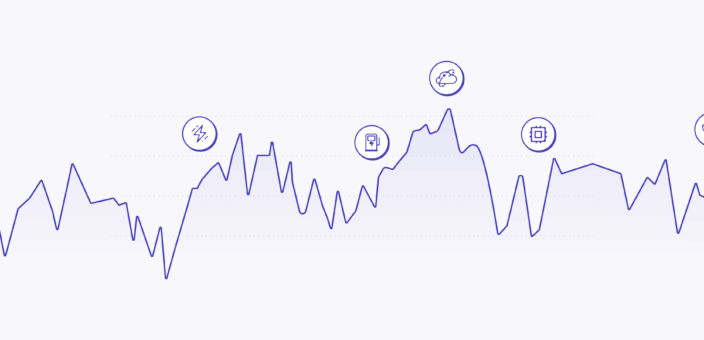Note: This piece originally appeared on Nasdaq’s website following the launch of Wealthfront’s Nasdaq-100 Direct. We are publishing it here with their permission.
For decades, the broad U.S. stock market has rewarded many investors with steady long-term growth—and concentrated exposure to some of the most innovative, growth-oriented companies has historically led to even higher returns. Investing in the Nasdaq-100 Index® is one way to get that exposure.
In the last 10 years, the Nasdaq-100® (represented by the QQQ® ETF) has delivered an annualized return of 19.43% net of fees, handily outperforming the broad U.S. stock market (represented by VTI) which saw annualized returns of 13.93% net of fees over this period through August of 2025.
Meanwhile, the biggest peak-to-trough loss for QQQ® was 32.55%, while VTI’s comparable decline was 24.81%. The lesson: Exposure to growth-oriented companies provides an opportunity to realize higher returns—but it also means riding out bigger swings along the way.
Direct indexing can make volatility work for you
The relative volatility of the Nasdaq-100® is good news if you use a direct indexing strategy. Direct indexing involves owning the individual stocks that make up an index and allows you to harvest losses from individual stocks—even when the index as a whole is up.
With tax-loss harvesting, capital losses are strategically recognized with the goal of lowering your tax bill. That means when an individual stock in the Nasdaq-100® declines below its purchase price, an investor can sell it, “harvest” a loss, and replace it with a similar stock to maintain the overall risk and return profile of the portfolio. These losses can then be applied against realized capital gains to lower your tax bill. Leftover losses can be applied against up to $3,000 of ordinary income, and any remaining losses carry forward to future years. Unlike ETFs, direct indexing gives you index exposure while turning day-to-day market moves into potential tax savings.
Wealthfront pioneered automated direct indexing for retail investors, and now they’ve brought that expertise to growth-oriented equities. Wealthfront’s Nasdaq-100 Direct is the first-ever product that lets retail investors access the Nasdaq-100 Index® through a direct indexing strategy, and it’s designed to give investors exposure to innovative companies and lower their tax bills at the same time. As Alex Michalka, Ph.D. and VP of Investment Research for Wealthfront explains:
“It’s very difficult to beat the market on a pre-tax basis, but investors can improve their after-tax returns with strategies like tax-loss harvesting. When you use a direct indexing strategy, volatility in the underlying stocks can work to your advantage and potentially generate significant tax savings. At the same time, you get similar performance to the index as a whole, much like an ETF. That’s why direct indexing is so compelling as a strategy—you get both.”
The advantage
Market volatility is inevitable—but with direct indexing, it can also work in your favor. And with a 0.12% annual advisory fee, Wealthfront’s new Nasdaq-100 Direct portfolio offers exposure to the index for less than the expense ratio of any Nasdaq-100® ETF currently on the market, including QQQ® and QQQM.
To learn more, click here.
Disclosure
The effectiveness of the tax-loss harvesting strategy to reduce the tax liability of the client will
depend on the client’s entire tax and investment profile, including purchases and dispositions in
a client’s (or client’s spouse’s) accounts outside of Wealthfront Advisers and type of investments
(e.g., taxable or nontaxable) or holding period (e.g., short-term or long-term).
Keep in mind, any harvested losses are first used to offset capital gains of the same type. This
means short-term losses are first deducted against short-term gains, and long-term losses are
deducted against long-term gains. Net losses of either type can then be deducted against the
other type of gain.
Tax loss harvesting may generate a higher number of trades due to attempts to capture losses.
There is a chance that trading attributed to tax loss harvesting may create capital gains and
wash sales and could be subject to higher transaction costs and market impacts. In addition, tax
loss harvesting strategies may produce losses, which may not be offset by sufficient gains in the
account and may be limited to a $3,000 deduction against income. The utilization of losses
harvested through the strategy will depend upon the recognition of capital gains in the same or
a future tax period, and in addition may be subject to limitations under applicable tax laws, e.g.,
if there are insufficient realized gains in the tax period, the use of harvested losses may be
limited to a $3,000 deduction against income and distributions. Losses harvested through the
strategy that are not utilized in the tax period when recognized (e.g., because of insufficient
capital gains and/or significant capital loss carryforwards), generally may be carried forward to
offset future capital gains, if any.
Wealthfront Advisers and its affiliates do not provide legal or tax advice and do not assume any
liability for the tax consequences of any client transaction. Clients should consult with their
personal tax advisors regarding the tax consequences of investing with Wealthfront Advisers
and engaging in these tax strategies, based on their particular circumstances.
Indices are not available for direct investment; therefore, their performance does not reflect the
expenses associated with the management of an actual portfolio. Nasdaq 100 Direct allows
clients to hold individual stocks in the Nasdaq-100 Index®, but it may not hold all the stocks in
the index. As a result, its performance may deviate from that of the Nasdaq-100 Index® due to
tracking error, market conditions, and the limitations of Tax-Loss Harvesting. Account size and
customization options, such as excluding individual stocks, may affect the portfolio’s ability to
track the Nasdaq-100 Index®.
Investing in direct indexing products and index ETFs both carry risks, including market
fluctuations and tracking error. While direct indexing may offer benefits such as tax-loss
harvesting and portfolio customization, it's crucial to compare all material differences such as
investment objectives, costs, liquidity, and tax features, before making an investment decision.
Nasdaq®, Nasdaq-100 Index®, NDX®, and Nasdaq-100® are registered trademarks of
Nasdaq, Inc. (which with its affiliates is referred to as the “Corporations”) and are licensed for
use by Wealthfront Advisers LLC. The Product(s) have not been passed on by the Corporations
as to their legality or suitability. The Product(s) are not issued, endorsed, sold, or promoted by
the Corporations. THE CORPORATIONS MAKE NO WARRANTIES AND BEAR NO LIABILITY
WITH RESPECT TO THE PRODUCT(S)
Nasdaq, Inc. is not associated with Wealthfront Advisers LLC, Wealthfront Brokerage LLC, or
any of their affiliates and has no formal relationship outside of this arrangement.
The information contained in this communication is provided for general informational purposes
only, and should not be construed as investment or tax advice. Nothing in this communication
should be construed as tax advice, a solicitation or offer, or recommendation, to buy or sell any
security. Any links provided to other server sites are offered as a matter of convenience and are not intended to imply that Wealthfront Advisers or its affiliates endorses, sponsors, promotes and/or is affiliated with the owners of or participants in those sites, or endorses any information contained on those sites, unless expressly stated otherwise.
All investing involves risk, including the possible loss of money you invest, and past
performance does not guarantee future performance. Please see our Full Disclosure for
important details.
Investment management and advisory services are provided by Wealthfront Advisers LLC
(“Wealthfront Advisers”), an SEC-registered investment adviser, and brokerage related products
are provided by Wealthfront Brokerage LLC, a Member of FINRA/SIPC.
Wealthfront, Wealthfront Advisers and Wealthfront Brokerage are wholly owned subsidiaries of
Wealthfront Corporation.
Copyright 2025 Wealthfront Corporation. All rights reserved.
About the author(s)



